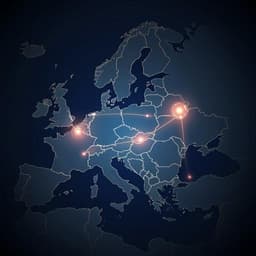
Environmental Studies and Forestry
How Joannites’ economy eradicated primeval forest and created anthroecosystems in medieval Central Europe
M. Lamentowicz, K. Marcisz, et al.
Explore how the economic activities of the Joannites significantly transformed primeval forests and wetland ecosystems in medieval Central Europe. This fascinating research, conducted by Mariusz Lamentowicz, Katarzyna Marcisz, Piotr Guzowski, Mariusz Gałka, Andrei-Cosmin Diaconu, and Piotr Kołaczek, unveils the rapid deforestation and ecosystem shifts that occurred during this pivotal historical period.
~3 min • Beginner • English
Introduction
The study addresses how medieval economic transformations—particularly those associated with the transition from tribal societies to feudal states—altered forest structure and wetland functioning in Central Europe. Large-scale deforestation and agricultural expansion, while prominent in the Anthropocene, began millennia earlier in Europe. Prior research has used multi-proxy paleoecological archives to reconstruct environmental history and human impacts, but high-resolution case studies at the forest–wetland interface during medieval state formation are scarce. The authors hypothesize that economic transformation linked to the rise of the Polish State, subsequent Brandenburgian colonization, and especially the Joannites’ (Knights Hospitaller) estate management near Łagów, caused irreversible forest modifications and cascading effects on peatland hydrology and ecology. The aims were to (1) infer effects of deforestation and fires on peatland development focusing on Joannites’ economic activity, and (2) reconstruct hydrological dynamics and its relation to human-induced vegetation changes.
Literature Review
Environmental history has often been reconstructed from sedimentary archives using multi-proxy approaches, revealing disturbances in forests and wetlands. In Europe, human impacts appear in paleoecological archives up to 6000 years ago, with notable accelerations during the Neolithic and Medieval periods. Studies show deforestation can drive critical ecosystem transitions, influence water tables, and alter wetland nutrient status; however, responses vary, including cases of drying, eutrophication, or terrestrialization. Medieval colonization and orders such as the Teutonic Order significantly modified landscapes in the Baltic region. Despite this, detailed, high-resolution reconstructions of land-use transitions and their impacts on adjacent wetlands during the tribe-to-state shift remain limited. The present study fills this gap by integrating historical sources (chronicles, inventories, maps) with paleoecological proxies to examine the Joannites’ influence on forest loss and peatland transformation near Łagów.
Methodology
Site: Pawski Ług, an ombrotrophic Sphagnum-dominated peatland (3.67 ha) in western Poland (Łagów Lakeland; 52°19′45″N, 15°16′30″E), surrounded by mixed forests of Quercus, Fagus sylvatica, and Pinus sylvestris. The mire is a nature reserve since 1970.
Coring: A 5-m core was obtained in spring 2016. The top 1 m was too unconsolidated for coring; thus, analyses were conducted on 100–500 cm. The upper 1 m was not analyzed. A Wardenaar sampler collected the top 1 m (unsuccessful for analyses), and an INSTORF sampler was used for deeper sections. Samples were stored frozen and subsampled for proxies.
Chronology: 29 AMS radiocarbon dates (Sphagnum stems) from 100.5–379.5 cm were measured at Poznań Radiocarbon Laboratory. Calibration used IntCal13 in OxCal 4.3. An age-depth model was constructed to cover the last ~1500 years.
Palynology: 80 samples (2 cm³) at 5 cm intervals prepared using standard methods with Lycopodium marker. Pollen, spores, and selected non-pollen palynomorphs were identified with reference keys. Counts targeted ≥500 total pollen per sample. Percentages were calculated relative to total pollen sum (AP+NAP, excluding aquatics, Cyperaceae, cryptogams). Human-indicator taxa were grouped into cultivated land indicators and major ruderals.
Charcoal: Microscopic charcoal (>10 µm) counted on pollen slides until charcoal+Lycopodium exceeded 200. Microscopic charcoal accumulation rates (MIC) computed as MIC = charcoal concentration × PAR. Macroscopic charcoal: 400 contiguous 1 cm³ samples bleached and wet-sieved at 100 µm, particles classified into four size fractions, analyzed at 60× magnification; macroscopic charcoal accumulation rates (MAC; particles/cm²/yr) calculated from concentrations and PAR.
Plant macrofossils: 400 contiguous samples (3 cm³) sieved at 125 µm; remains identified with a reference collection. Volume percentages estimated; discrete remains (seeds, Betula catkin scales, Eriophorum spindles, Carex nutlets, Chara oospores, Sphagnum spore capsules) counted as numbers per subsample.
Testate amoebae (TA): 2 cm³ samples, same depths as pollen/charcoal, washed through 0.3-mm sieve. Identified under light microscope (200–400×), minimum 100 tests per sample. TA data used to reconstruct depth-to-water table (DWT) with a regional transfer function (northern Poland) implemented in C2.
Statistics and visualization: Proxy diagrams plotted in C2 and Tilia; zones defined by pollen and NPP spectra. Synthesis figure produced with DataGraph and edited in Affinity Designer. TA-based quantitative DWT reconstructions in C2 using a local training set. Nonmetric Multidimensional Scaling (NMDS; Bray–Curtis) run in R (vegan); environmental variables (DWT, MIC, MAC, vascular plants, Sphagnum) fitted post hoc with envfit to explore temporal trajectories.
Key Findings
- Three main land-use and ecosystem stages over the last 1500 years were reconstructed, corresponding to Slavic/early Polish State (pre-1350 CE), Joannites/Brandenburgian colonization (1350–1812 CE), and post-Joannites (after 1812 CE).
- ca. 500–1350 CE: Dense mixed forests (Pinus sylvestris, Betula, Alnus, Quercus) dominated; AP >90%. Poor fen conditions with open water indicated by persistent Nymphaea alba sclereids and high Nymphaeaceae idioblasts; Botryococcus increases during wetter phases. TA indicate highest water tables ca. 900–1200 CE; brief lowering at ca. 500 CE to ~15 cm DWT. Local fires occurred regularly (macrocharcoal), with six peaks and a decline around 870 CE; microcharcoal indicates increasing regional fire later. Human indicators low; coprophilous fungi suggest presence of herbivores/omnivores.
- Transition ca. 1300–1350 CE: Marked decline in Carpinus betulus and other broadleaved taxa signals accelerating deforestation. NMDS shows a critical transition at 1350 CE along a gradient of increasing human pressure.
- ca. 1350 CE onwards: Rapid landscape opening and agricultural expansion (increases in Poaceae, Plantago lanceolata, Rumex acetosa type; Secale cereale, Cerealia, Fagopyrum esculentum). Forest restructuring with expansion of Pinus sylvestris, retreat of Betula, and abundant Quercus; overall AP declines towards top. Local fires cease after ca. 1350 CE (likely due to diminished local fuel availability), while regional fires continue (microcharcoal), with peaks possibly linked to conflicts.
- Peatland state shift: Transition from alkaline wet fen with open water to acidic, drier Sphagnum-dominated peatland. Loss of open-water macrofossils after 1350 CE. TA-inferred DWT shallows to ~10 cm, with mixotrophic taxa dominance and indicators of hydrologic instability (e.g., Arcella discoides). Negative correlation observed between deforestation events and mire acidification, with Sphagnum abundance closely tracking catchment processes; short hornbeam regeneration events coincide with temporary Sphagnum declines.
- Peat accumulation: Rapid and sustained peat growth in the Sphagnum phase over the last ~600 years with fast accumulation rates (~2.6 mm/yr), consistent with development of a floating Sphagnum mat under stable, high water table conditions.
- Post-1800 CE: Forest regeneration (Fagus sylvatica, Betula) around the mire; cereal pollen increases alongside decline of coprophilous fungi, indicating a shift from grazing to croplands and changing land management after the Joannites’ dissolution.
- Historical synthesis: Settlement intensification from the mid-13th century under Brandenburgian control and establishment of the Joannites’ commandery at Łagów led to modernization of agriculture (three-field rotation, heavy plows, iron harrows, monetization), expansion of large peasant farms (mansi), and sustained deforestation. These changes rapidly eliminated pristine forests (within ~200 years) and created a novel, human-shaped anthroecosystem.
Discussion
Findings support the hypothesis that medieval economic reorganization—especially under the Joannites—produced an abrupt, irreversible transition from a largely pristine, fire-affected forested landscape to an open, agricultural mosaic. Deforestation and intensified land use altered catchment microclimate and hydrology, driving a peatland regime shift from a mesotrophic wet fen with open water to an oligotrophic, Sphagnum-dominated system. The strong coupling between forest structure and peatland state is evidenced by synchronized declines in broadleaved trees, cessation of local fires, rise of agricultural indicators, and TA-inferred hydrological change. The study highlights how feudal economic systems can rapidly eliminate primeval forest and engineer novel anthroecosystems, with legacy effects persisting for centuries. The hydrological interpretation considers two mechanisms: (1) overall water table lowering and ombrotrophication, or (2) fen acidification facilitating development of a floating Sphagnum mat under relatively stable hydrology; proxy coherence favors the latter. Results contribute to broader debates on the timing and nature of the Anthropocene and demonstrate the value of integrating paleoecology with historical records to resolve drivers of ecological regime shifts.
Conclusion
This high-resolution, densely dated multi-proxy record from Pawski Ług demonstrates that medieval feudal economy—modernized under the Joannites—rapidly transformed a primeval forested landscape into an open, agricultural anthroecosystem and drove a peatland state shift to a Sphagnum-dominated bog. The work provides one of the clearest paleoecological documentations of tight forest–wetland coupling, showing how deforestation and microclimatic changes cascade into long-lasting wetland transformations. By aligning ecological proxies with detailed historical sources, the study refines understanding of human impacts in medieval Central Europe and informs discussions on the emergence of novel ecosystems and the Anthropocene.
Limitations
- The unconsolidated upper 1 m of peat could not be recovered for proxy analyses; consequently, the study focuses on the 100–500 cm section, limiting direct observations of the most recent centuries in the same resolution.
- Hydrological interpretation entails some uncertainty: two alternative mechanisms (drying and ombrotrophication vs. fen acidification and floating mat development) were considered, with the latter favored but not uniquely demonstrable from available proxies.
- Human impact intensity is inferred indirectly from paleoecological indicators and historical sources; direct archaeological quantifications at the mire’s immediate catchment are limited.
Related Publications
Explore these studies to deepen your understanding of the subject.







